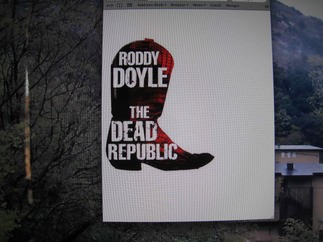Monday, 26 September 2011
 While you don't always get the chance to read a series of novels in the right order there's a desirable sequence, and, as a corollary, an undesirable one.
While you don't always get the chance to read a series of novels in the right order there's a desirable sequence, and, as a corollary, an undesirable one.
I came to Roddy Doyle's trilogy about the life and times of Henry Smart through a passing reference to his role as Louis Armstrong's white man in a review of 2004's Oh, Play That Thing, hunted it down and, having read it, set off in search of A Star Called Henry.
Oh, Play That Thing worked well enough as a stand alone story with the back story that explained Henry Smart's hasty exit from Ireland efficiently filled in, and going from there to A Star Called Henry enriched that back story and provided ample explanation for someone's involvement with the antecedents of recent Irish Republican terrorist attacks.
It must be difficult for someone sitting around the cusp of the twenty-first century, back in that pre-GFC period when Ireland was still the Celtic Tiger and offered tax-free status to creative writers to grasp the awful realities of slum life in urban Dublin a century earlier.
Having read A Star Called Henry I was left wondering why anyone wouldn't have gone down the path that took Henry Smart from the Dublin slums to become the youngest participant in the Easter Rising and from there to assassin status in the revolutionary years from 1916 to 1921.
It's also obvious there are some people you don't want around when the desired result of revolutionary activity looks within reach, so I could understand why someone would be signing the hard man's death warrant, and, equally, why the hard man would be looking to make himself scarce.
Smart's flight across the Atlantic brings him right into the middle of the Jazz Age and the Great Depression, and while you could take issue with the likelihood of the detail, Smart's reunion with his wife, who happens to have been his teacher and partner in terrorist action, provides the basis for a lively run through the thirties, culminating in the fall from a boxcar that costs Smart a leg and separates him from his family.
He's still doing it tough and sleeping rough when he crawls off into the desert to die, only to be resurrected at the end of Oh, Play That Thing when a casual act of urination brings movie director John Ford into the equation and provides a starting point for The Dead Republic.
While it's possible to take issue with some of the detail up to this point things work well enough as a narrative to encourage the reader to suspend disbelief and accept repeated coincidences that seem, on the surface, to be far too coincidental.
Which is where the sequencing bit comes in. While the best sequence to read the trilogy is 1-2-3, my 2-1-3 spread over five or six years worked for me, and having gone 2-1 I was scanning the horizon for 3, which slipped by unnoticed a little over twelve months ago and probably appeared in the reviews section of The Weekend Australian within a week or two of Hughesy's giving it the flick pass.
I may well have passed over a hard copy without noticing on one of my infrequent bookshop visits but a Google a couple of weeks ago advised of the book's existence, and since there was a digital version in the Kindle store, here we are with a three-part story that runs through the later years of what would have been a remarkable life.
The story begins with Henry Smart's resurrection as 'IRA consultant’ as Irish-American director John Ford sets out to turn Henry’s story into a screenplay. He eventually does, though The Quiet Man, directed by Ford and starring John Wayne and Maureen O'Hara, bears no resemblance to the details we know from A Star Called Henry.